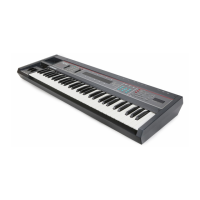SQ-80 — Musician's Manual
Throughout the rest of this Section you will learn about the Waves, Modulators. and Envelopes, and how to
control the pitch and volume of each Oscillator. Once you are familiar with the basic operations, try
examining some of the Factory Programs to see which Waves are played by the different Oscillators
(OSC 1-3 Pages), and how the volume of each Oscillator has been programmed (DCA 1-3 Pages).
WAVES
Digital Wave Memory
The
SQ-80's CrossWave
TM
synthesis technique is based on the ability of its three Digital Oscillators to
"read" from memory whichever Waves they are instructed to play for each Program (rather than just
producing simple sawtooth or square waves). The
SQ-80 has 256 kilobytes of wavedata in ROM to use
in constructing sounds.
This wavedata is divided among 75 different Waves stored in the
SQ-80's Digital Wave Memory. Many
of these Waves have been sampled (digitally recorded) from real musical sources: others have been
created synthetically. Some were sampled and then re-synthesized using various Digital Signal
Processing techniques.
Waveforms, Inharmonic Loops and Transient Attacks
The Waves which form the "raw material" of the
SQ-80 sounds are divided into three basic categories
— Waveforms, Inharmonic Loops and Transient Attacks. Though Waveforms, Inharmonic Loops and
Transient Attacks are all forms of digitally encoded sound, they differ in fundamental ways.
• A
Waveform is a single cycle of a sound wave. It is Digitized, or converted into a series of numbers,
and stored in Memory. By rapidly repeating this single cycle over and over, an Oscillator can produce a
pitched sound which becomes a continuous Sound wave:
Unlike the sounds generated
by analog oscillators, Digital
Waveforms can be very com-
lex. and can contain any
combination of harmonics —
frequencies that are multiples
of the wave's fundamental
frequency. Every Waveform
has its own unique
Spectrum,
which is the number and am-
litude of harmonics present
in the Wave. It is this Spec-
trum which gives every sound
its own identifiable characteristics.
The SQ-80 has 49 Waveforms. The first 32 Waveforms are the same as those in the ENSONIQ ESQ-1.
This means that ESQ-1 sounds can be played on the SQ-80. The reverse is partially true — SQ-80
sounds which use only the bottom 32 Waveforms (none of the other Waveforms, Transient Attacks or
Inharmonic Loops) will usually play properly on the
ESQ-1. However, any SQ-80 sounds which use
Transient Attack or Inharmonic Loop Waves will tend to produce unpredictable results when played on
the
ESQ-1 (until the Program is modified to use waveforms which are legal on the ESQ-1.)
30 Section 3 — Voice Programming

